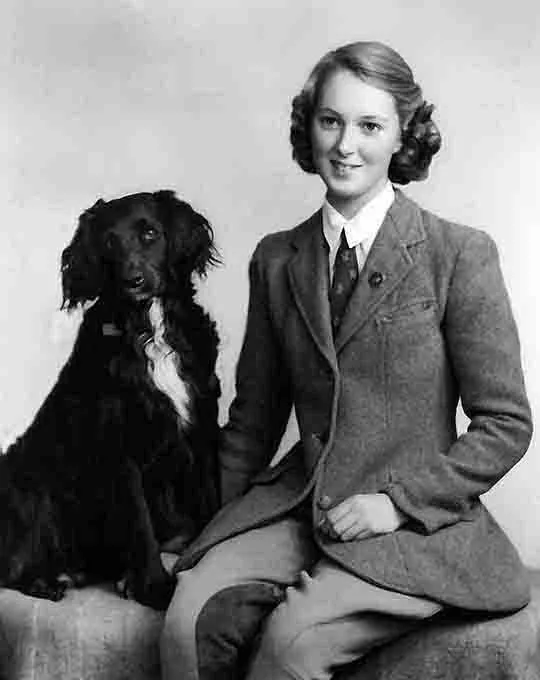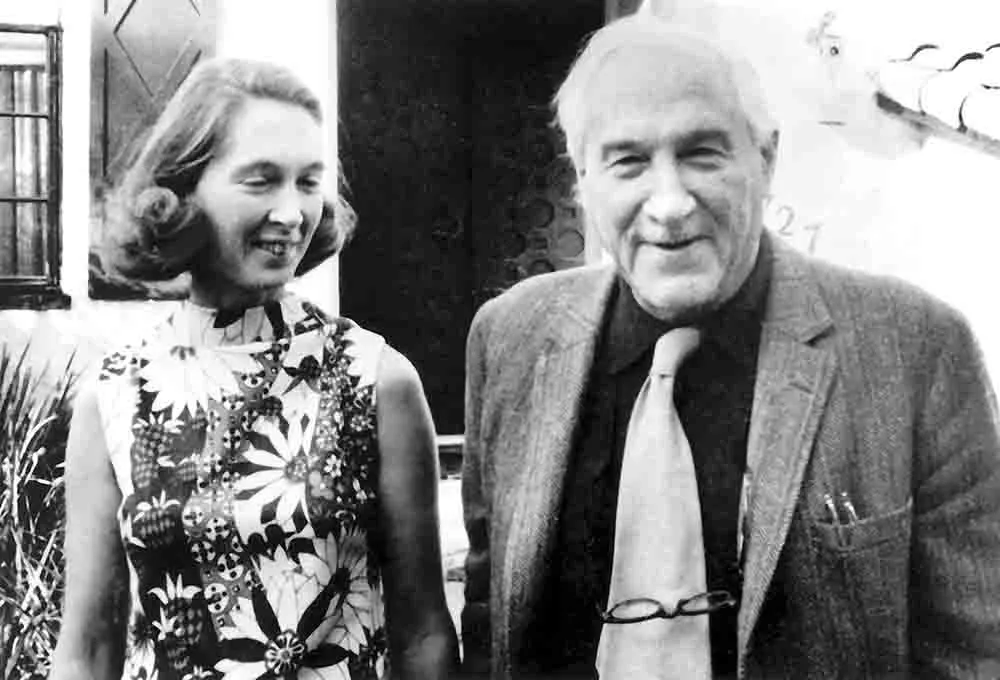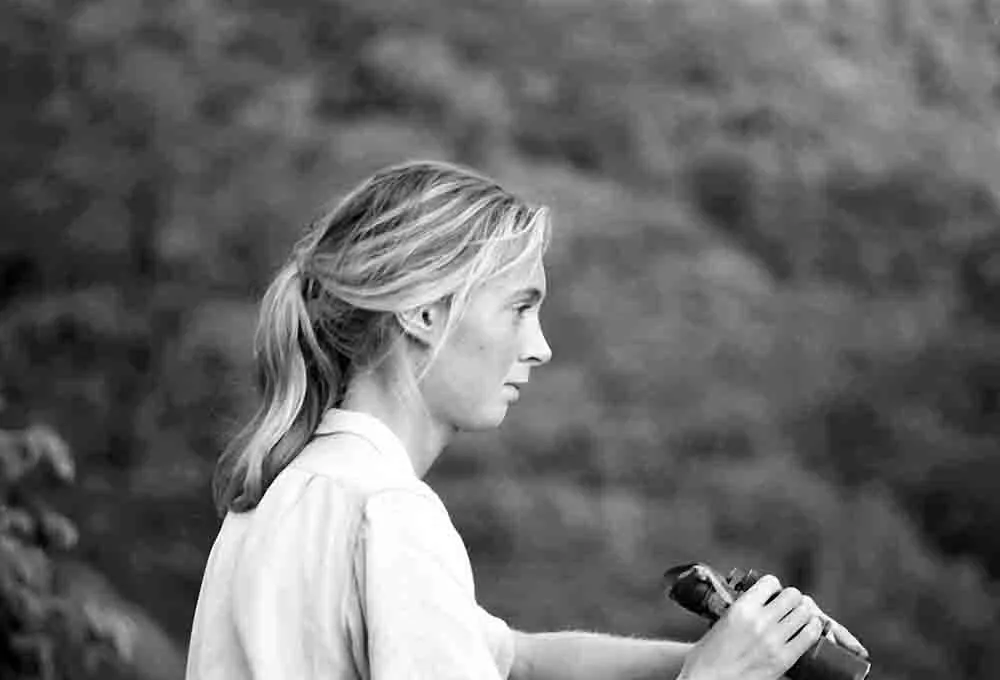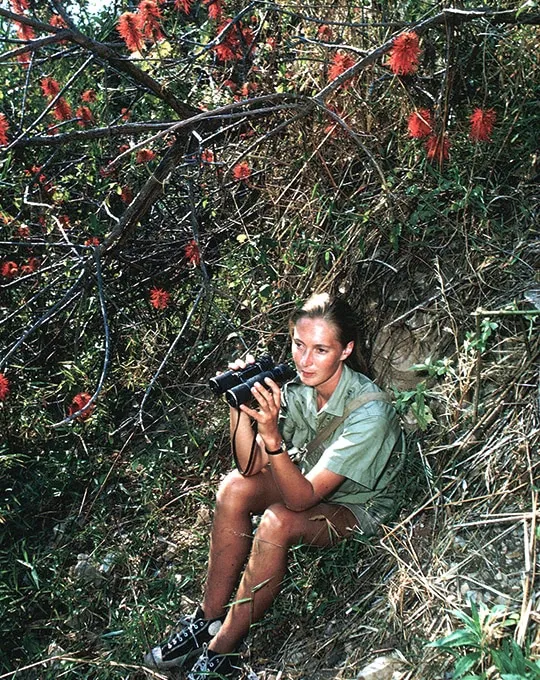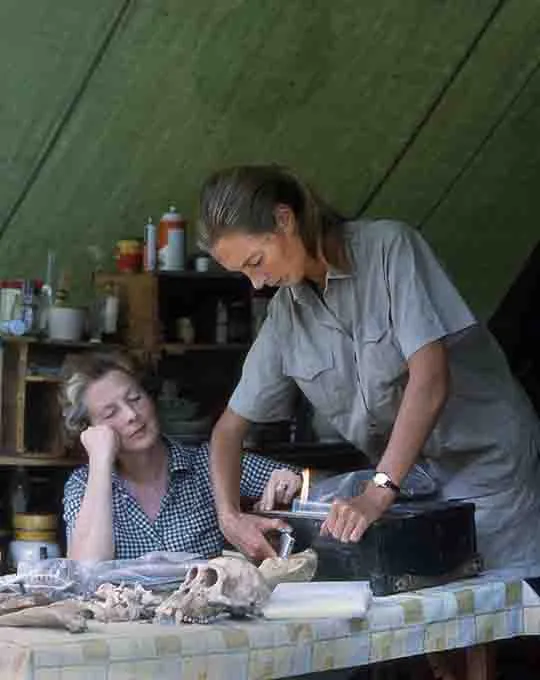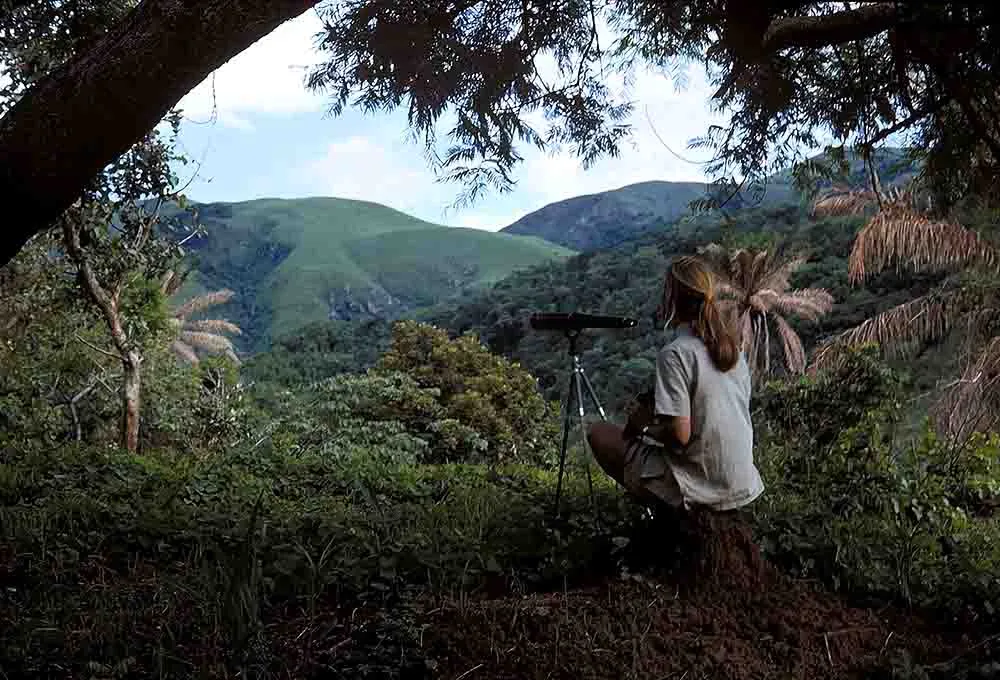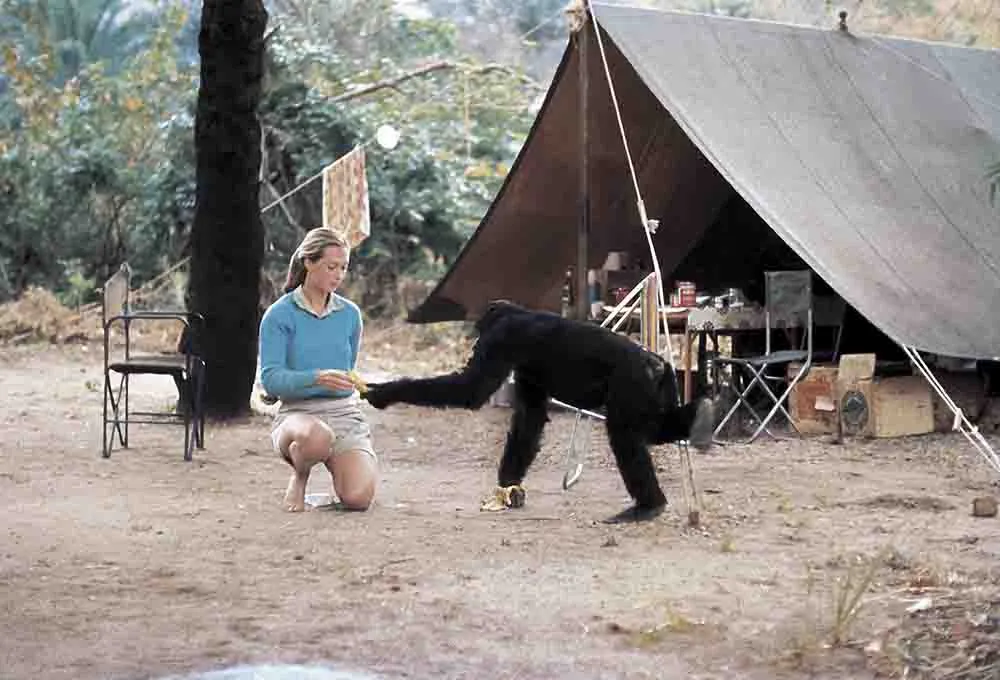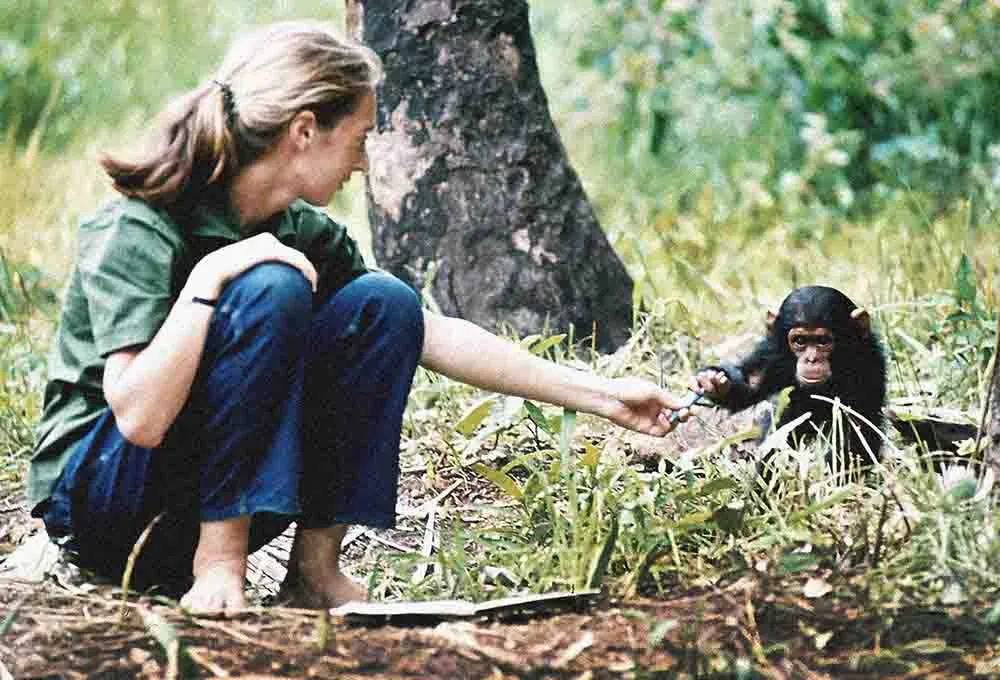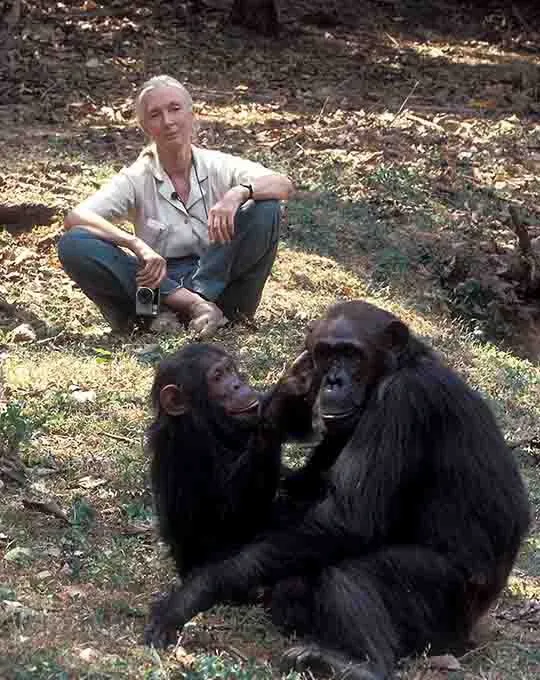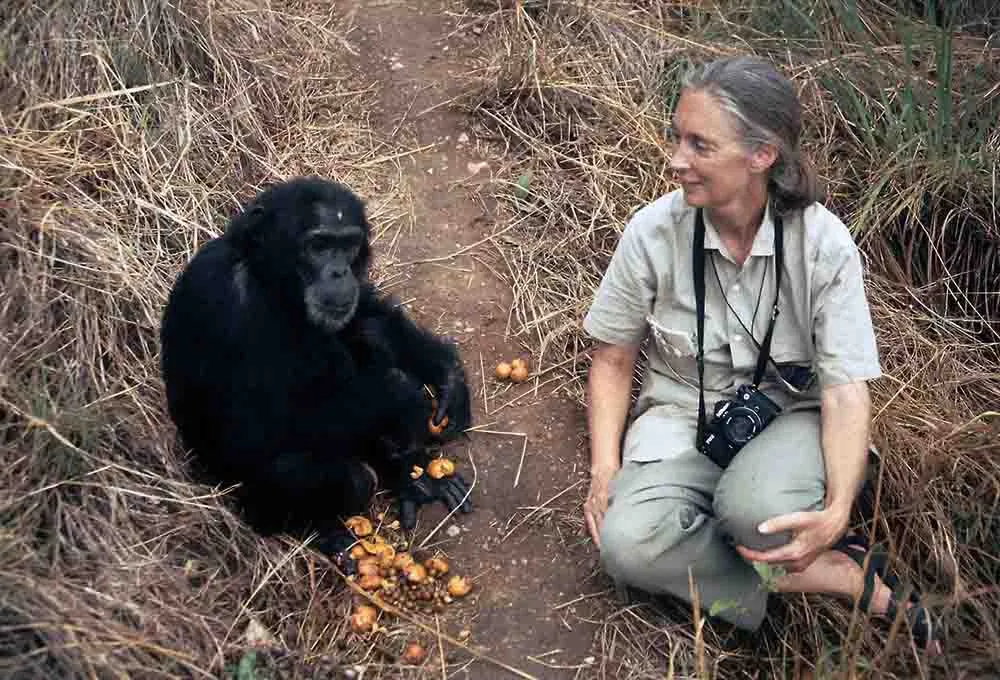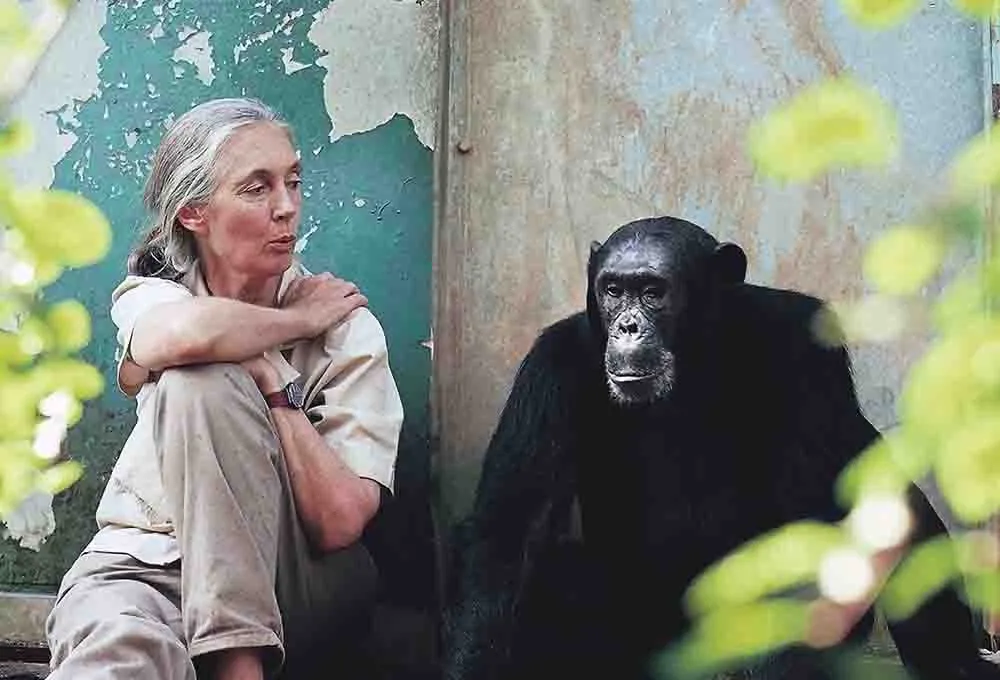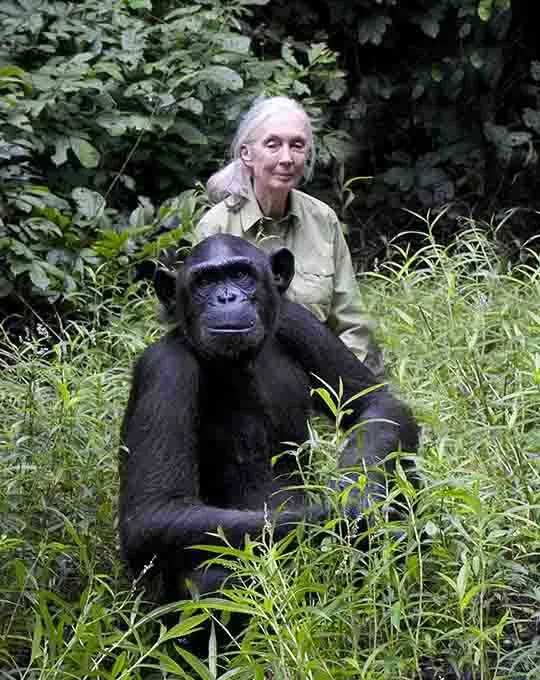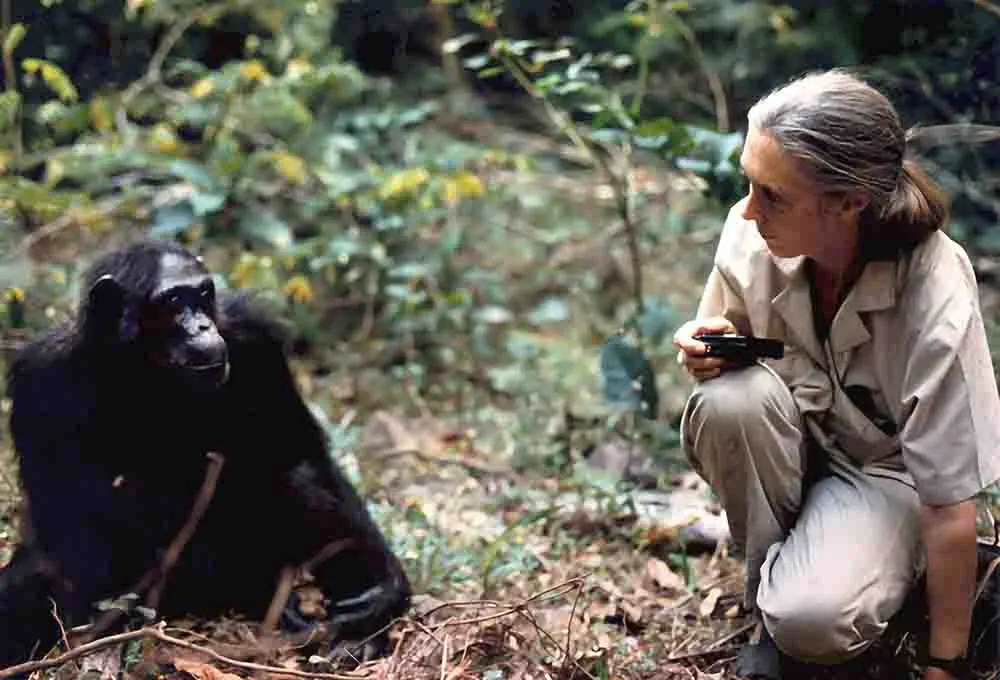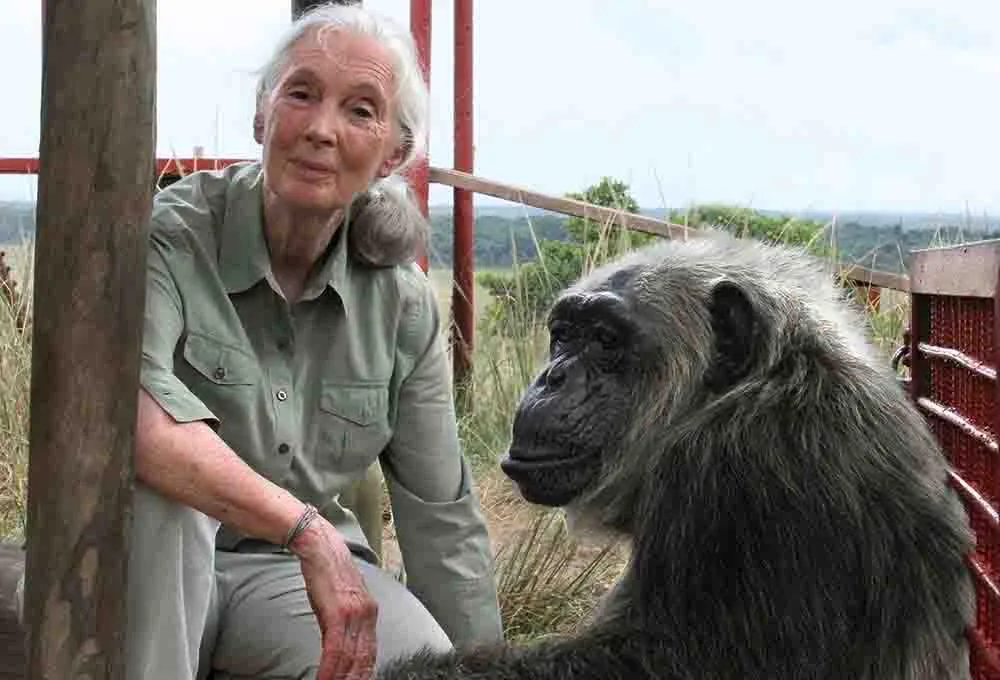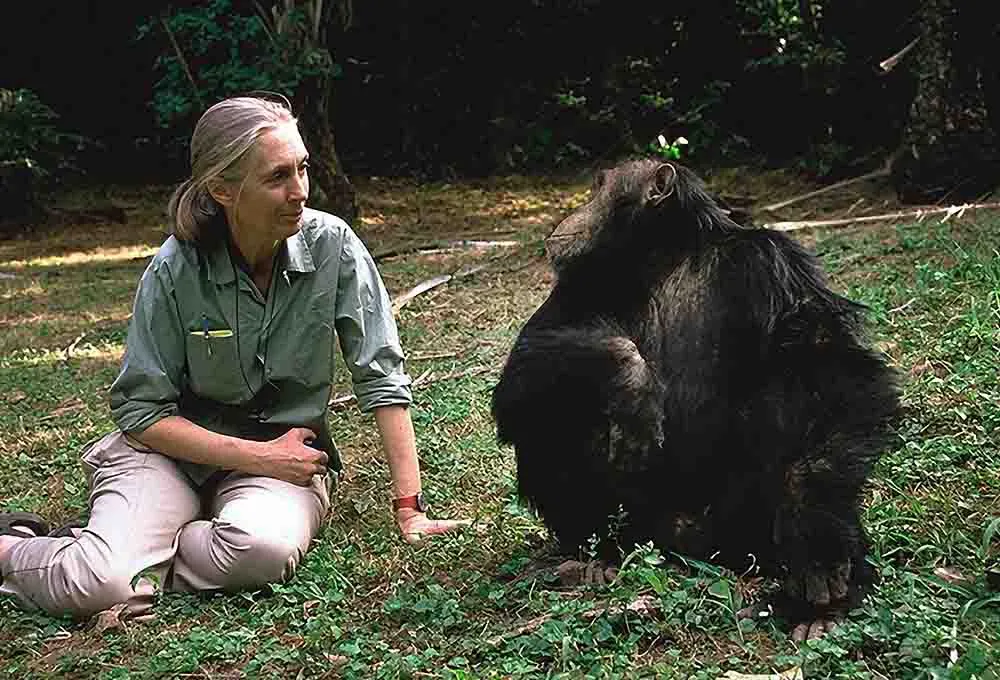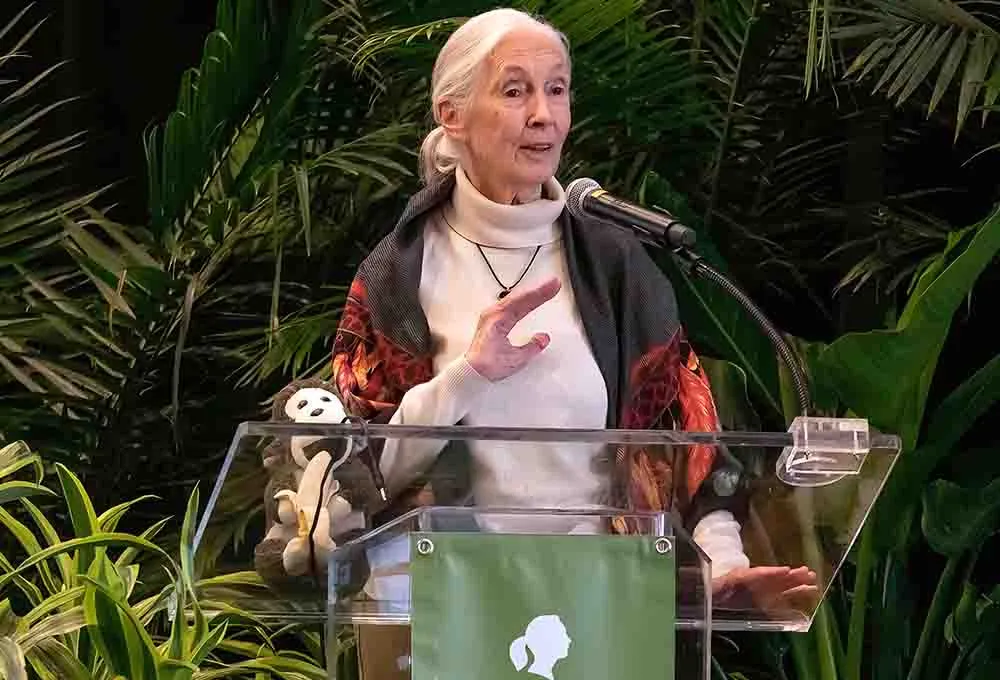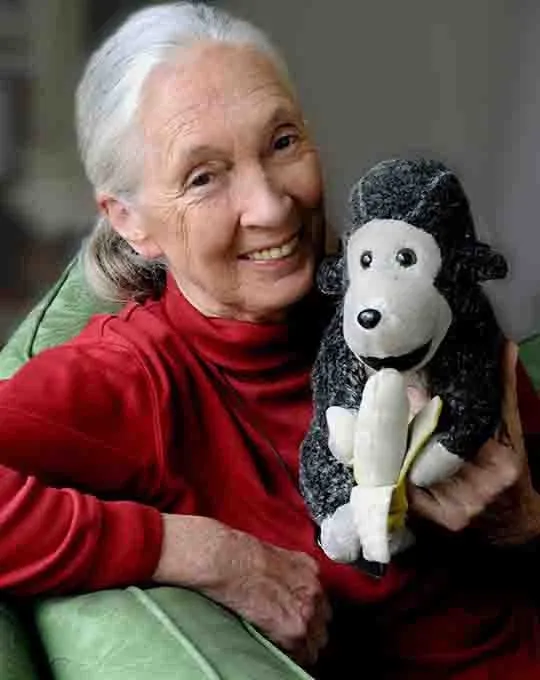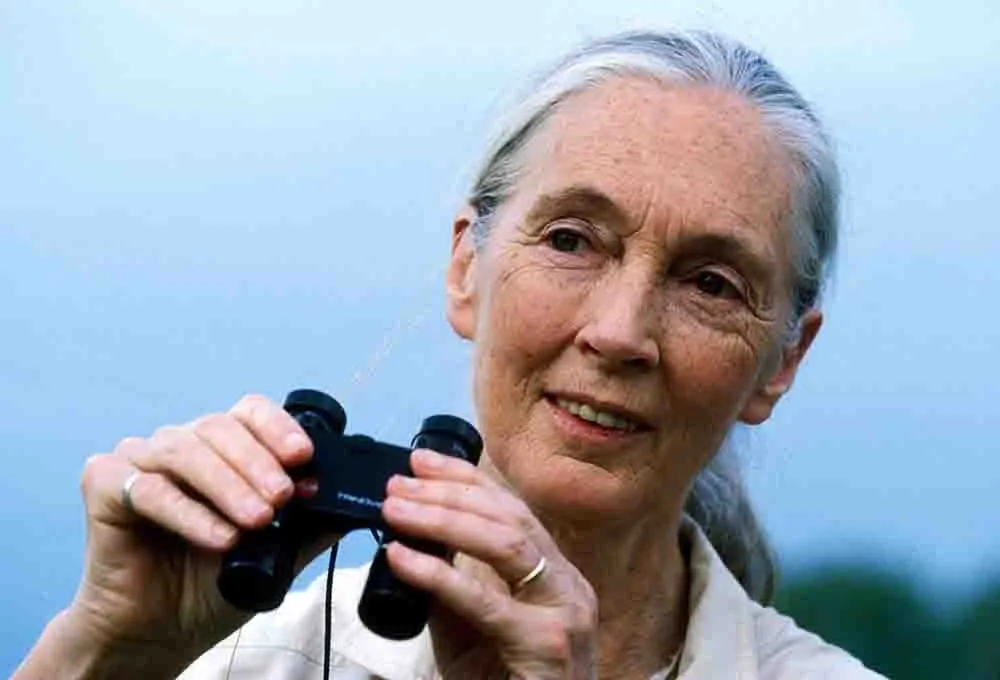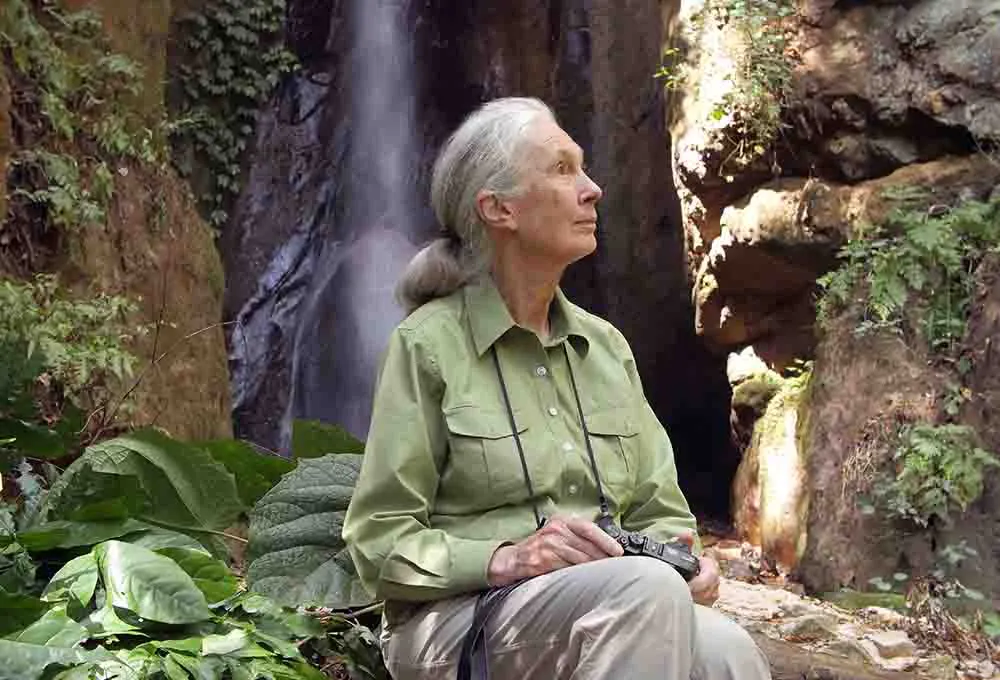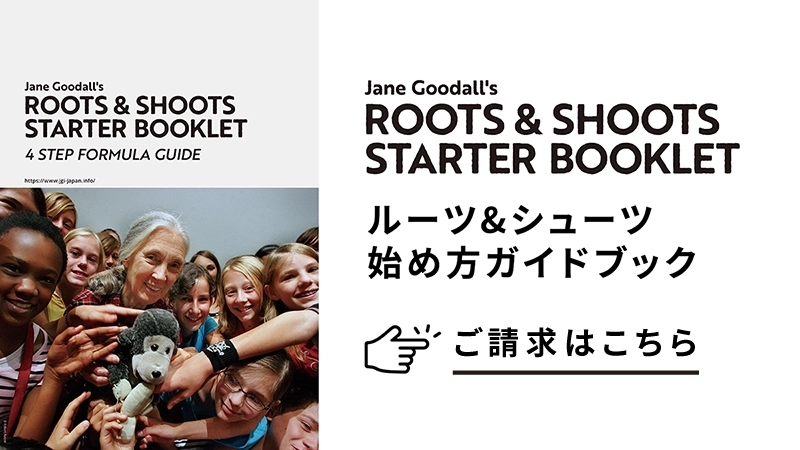© JGI/Hugo van Lawick
about Jane Goodall
1934
ジェーン・グドールは
イギリスのロンドンで生まれました。
1934年4月3日、イギリスのロンドンで生まれたジェーン・グドール。ジェーンは小さな頃から動物が好きで、よく裏庭で鳥やリスを日が暮れるまでじっと観察している少女でした。また、ターザンやドリトル先生の本を読んでは、動物に囲まれて暮らすのを夢見ていました。
Valerie Jane Morris-Goodall was born on April 3, 1934, in London. From earliest childhood, Jane’s mother encouraged her fascination with animals. Young Jane immersed herself in books about wild animals and dreamed of a life alongside African wildlife like Tarzan and Dr. Dolittle.
ルイス・リーキー博士との出会い
動物に対する飽くなき探究心を胸に、1957年に友人を頼ってケニアへと渡り、そこで人類学の権威ルイス・リーキー博士と出会います。当時、リーキー博士は「ヒト」の祖先を研究する上で、類人猿のフィールド調査を行う人材を探していました。
動物に対する情熱と知識、そして鋭い観察力と強靭な忍耐力をジェーンが備えていることを見てとったリーキー博士は、6カ月間の研究資金を集め、ジェーンを野生チンパンジーが生息するアフリカへと送り出したのです。
Jane’s Mentor Dr. Louis Leakey
In 1957, Jane eagerly accepted a schoolmate’s invitation to the family farm in Kenya. Within a few months of arriving, she met the famed paleoanthropologist, Dr. Louis Leakey. Dr. Leakey was searching for the right person to study fellow great apes, particularly chimpanzees. This was not only to better understand these little-known primates, but also to gain insight into the evolutionary past of humans, as chimpanzees and humans share a (most recent) common ancestor some 6 million years ago. He was drawn to Jane’s persistent desire to understand animals and believed that a mind uncluttered by the reductionist thinking of ethologists of the time would yield a fresh perspective.
1960
東アフリカのタンガニイカ湖のほとり、ゴンベの地へ。
こうしてジェーンは、1960年7月、東アフリカのタンガニイカ湖のほとり、ゴンベの地におりたったのです。
誰もがジェーンに対して、「経験も学位も持たない26歳の女性が、アフリカ奥地の密林で調査研究などできるわけがない」と言いました。しかし、幼少期からジェーンの好奇心を育んできた母ヴァンネは、ステレオタイプを取り払い、夢を支え続けました。
In July 1960, Jane arrived on the shores of Lake Tanganyika in what is now Gombe National Park, Tanzania, East Africa. Everybody said, “How will you do that? You don’t have money. Africa’s far away. It’s a dangerous place and anyway you’re just a girl. Girls don’t do that sort of thing.”, except her mother, who encouraged Jane’s dream.
フィールド調査のはじまり
ジェーンが調査を開始した当初は、チンパンジーたちはジェーンを見るなりすぐ逃げてしまい、近づくことすらできませんでした。しかし、ジェーンは諦めることなく、山頂に登っては双眼鏡を使ってチンパンジーを静かに観察し続ける日々を繰り返しました。
徐々にチンパンジーたちとの距離が縮まり、彼らの特長をつかみ顔を見分けることができるようになったので、ジェーンは一人ひとりに名前をつけてゆきました。名前をつけることは現在のフィールド調査では主流になっていますが、当時はこの手法自体が型破りだと言われていました。なぜなら、研究者たちは調査対象の個体を番号で呼び、個性や感情は人間だけしか有していないと考えられていたからです。
初期にジェーンが発表した論文では、チンパンジーを擬人化しすぎているという指摘を受けました。もちろん、事実と調査する側の主観的な解釈とを混同しないよう注意する必要があるのは確かなのですが、ジェーンがチンパンジーの「心」の深遠さに注目したからこそ、さまざまな成果が生まれたのではないでしょうか。
Jane Arrives in Gombe
Equipped with little more than binoculars, a notebook and her fascination with wildlife, Jane ventured into what was then called the Gombe Stream Chimpanzee Reserve – embarking on a journey that would redefine the relationship between humans and other animals and ultimately help shape the burgeoning strategies of world conservation into the 21st century.
She took an unorthodox approach, immersing herself in the chimpanzee’s habitat. After months of trying to gain their trust, she was able to experience their complex society as a neighbor, rather than a distant observer. She then further defied scientific convention by giving them names instead of numbers. She came to understand them not only as a species, but as individuals with personalities, complex minds, emotions, and long-term bonds.
科学界を揺るがす大発見
1960年10月、“白ひげのデイビッド”とジェーンが名付けたチンパンジーとの話は、彼女のキャリアを語る上で外せない代表的な功績のひとつです。当時の科学では、人間と動物を分かつものは、「道具を作り、使うこと」と考えられていました。しかし、デイビッドが葉をきれいに取り除いた茎をアリ塚に差し込み、シロアリをつりあげて食事する様子をジェーンは目撃したのです。「大変だ! 人間と道具を定義し直すか、チンパンジーを人間として受け入れなければ!」リーキー博士のこの言葉は、いかにこれが科学界を揺るがす発見だったかを物語っています。この発見により、ナショナルジオグラフィック協会が研究のスポンサーとなり、その後も調査研究が続けられることとなったのです。
Revolutionizing Primatology
One day, in October 1960, she saw the chimpanzee she named David Greybeard use grass stems to fashion tools for fishing termites from their nest. Up until that revelatory moment, mainstream scientists thought humans were the only species to make and use tools, having defined us as “Man the Toolmaker.” Her insights rocked the scientific world, prompting Dr. Leakey to proclaim, “Now we must redefine man, redefine tool, or accept chimpanzees as humans!” Her published findings on the tool-making practices of chimpanzees remain one of the most highly regarded observations in the world of animal behavior research.
32歳ではじめて取得した学位
ゴンベでの最初の数年間で、ジェーンはチンパンジーに対する私たちの理解を一変させる行動をいくつも発見しました。チンパンジーは思いやりがあり利他的であること、狩りをし肉を食べること(ただし、食事に占める割合は3%以下)、原始的な戦争をすること、家族間(特に母子)に深い絆があること。
1961年、ジェーンはケンブリッジ大学に博士号候補生として入学。修士課程を修了せずに入学を認められた8人目の生徒となりました。そしてゴンベでの研究を継続しながら、1966年に動物行動学の博士号を取得しました。彼女が始めたチンパンジーの研究は現在も多くの研究者が継承し、人間以外の動物に関する最も長い研究となっています。
Ph.D. in Ethology
During her first years at Gombe, she also observed several other behaviors that transformed our understanding of chimpanzees. This included that they 1) Can be compassionate and altruistic, 2) Will hunt and eat meat (though it is less than 3% of their diet), 3) Can engage in “primitive warfare,” and 4) Have lasting bonds between family members (all species have strong mother-infant bonds). In 1961, Jane entered Cambridge University as a Ph.D. candidate, only the 8th person to be admitted without an undergraduate degree. She repeatedly returned to Gombe to continue her observations throughout her time at Cambridge, before earning her Ph.D. in Ethology (animal behavior) in 1966 and continued her research in Gombe.
1977
ジェーン・グドール インスティテュートの創設。
ゴンベ・ストリーム・リサーチ・センターでの研究を持続可能にしていくと同時に、ジェーンの調査研究はチンパンジーや動物たちが暮らす森林の保護活動へと拡大し、1977年にジェーン・グドール インスティテュートを創設しました。
地球が壊れていく姿を目撃し、その現状に希望を失った子どもたちと出会ったジェーンは、1991年にユースの環境保護プログラム「ルーツ&シューツ(ROOTS & SHOOTS)」を開始。また、貧困や教育の問題と環境破壊の負の連鎖を食い止めるべく、1994年にはアフリカ初のコミュニティ主導型の環境保護プログラム「タカリ(TACARE)」を立ち上げました。現在、ルーツ&シューツは世界中に広がり、今では年間100万人もの子どもたちが参加しています。また、12の村からはじまったタカリは、現在100以上の村で実施され、その地に暮らす人々の暮らしが改善されていったと同時に、多くの森が回復し、これまでの努力が実を結んでいます。これまでの献身的な活動を讃え、2002年に国連平和大使に任命されました。
In 1977, Jane established the Jane Goodall Institute (JGI) to advance her vision around the world and for generations to come. JGI continues essential research at Gombe Stream Research Center and is a global leader in the effort to protect chimpanzees and their habitats through community-led conservation.
The organization also advances best practices in animal welfare, innovative applications of science and technology, and youth empowerment through its Roots & Shoots program, created in 1991. In 1994, JGI launched TACARE, a program supporting locally managed education and socio-economic development together with sustainable natural resource management. In April 2002, Secretary General Kofi Annan named Jane a United Nations Messenger of Peace.
Today
希望のメッセンジャーとして
歩み続ける。
コロナ禍になる直前まで、ジェーンは年間300日を費やしながら世界各地で講演活動を行い、気候変動対策を呼びかけ、行動へと促す希望の種を蒔いてきました。世界中がロックダウンに見舞われる中でも、“バーチャル・ジェーン”と題して365日リモートで世界中と繋がり、講演会や取材に応じ、ポッドキャストを通して心に届くストーリーを伝えてきたジェーン。国境が開かれた現在、希望の伝道師は今日もまた、世界中を忙しく飛び回っています。
「私たちは、人も、動物も、自然も、分け隔てなくリスペクトすることが大事」
JGIジャパンは、ジェーンの思いに共感した皆様と一緒に、この美しい地球の住人の一員として活動を広めてゆきたいと思います。
Prior to the Pandemic, Jane traveled on average 300 days per year, speaking about the threats facing chimpanzees, other environmental crises, and her reasons for hope. Today, Jane continues to connect with worldwide audiences, despite present challenges, through ‘Virtual Jane’ including remote lectures, recordings, and her podcast, the “Jane Goodall Hopecast.” She shares her message of hope and inspires people worldwide to take action on behalf of people, other animals, and the planet every single day…
“Respect for each other. Respect for the environment. Respect for Animals.”
Jane gave us this vision and started this work. The rest is up to us. Together, with everybody making a difference, we can change the world.
これまでの受賞・受勲
1963 フランクリン・バール賞(ナショナルジオグラフィック協会) / 1980 ゴールデンアーク勲章(野生動物保護活動に対し) / 1987 アルベルト・シュバイツァー賞 / 1990 京都賞(稲森財団) / 1995 ハバード・メダル賞(ナショナルジオグラフィック協会) / 2001 ガンジー・キング賞 / 2002 コフィ・アナン国連事務総長より平和大使に任命される / 2002 エリザベス女王よりDBE(大英帝国勲位)に叙せられる / 2003 ベンジャミン・フランクリン・メダル賞 / 2003 スペイン皇太子賞(科学技術部門) / 2017 コスモス国際賞(国際花と緑の博覧会記念協会) / 2021 2021年度テンプルトン賞
Awards and Honors
1963 Franklin Barr Award (National Geographic Society) / 1980 Golden Ark Medal (Honor for Wildlife Conservation) / 1987 Albert Schweitzer Award / 1990 Kyoto Prize (Inamori Foundation) / 1995 Hubbard Medal Award (National Geographic Society) / 2001 Gandhi King Award / 2002 Appointed Ambassador for Peace by UN Secretary-General Kofi Annan / 2002 DBE (Order of the British Empire) by Queen Elizabeth II / 2003 Benjamin Franklin Medal Prize / 2003 Prince of Spain Prize (Science and Technology) / 2017 International Cosmos Prize (Commemorative Association for the International Garden and Greenery Exposition) / 2021 Templeton Prize
博士号を授与した大学名
オランダ・ユトレヒト大学 / ドイツ ミュンヘン・ルートウィヒ-マクシミリアンズ大学 / スコットランド・スターリング大学 / 台湾・プロビデンス大学 / カナダ・グェルフ-ライアーソン大学 / 米国・バッファロー大学、タフツ大学 / 京都大学(2007年)など
Honorary Doctorates
Utrecht University, The Netherlands / Ludwig-Maximilians-Universität München, Germany / Stirling University, Scotland / Providence University, Taiwan / Guelph-Ryerson University, Canada / University at Buffalo, Tufts University, USA / Kyoto University

